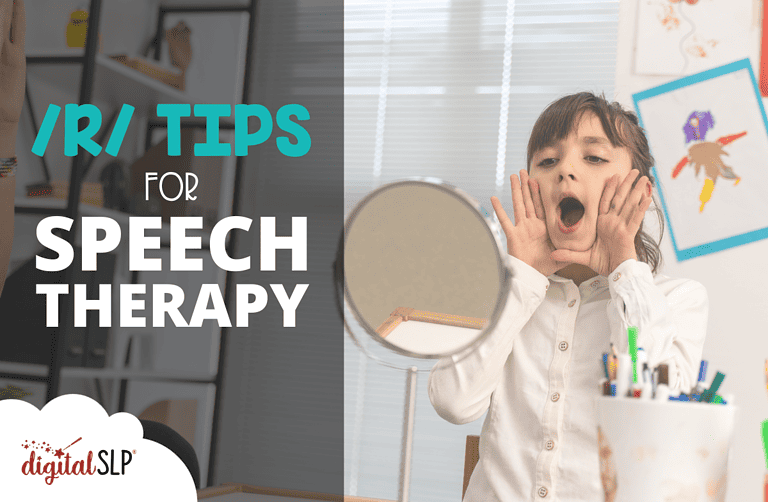Many SLPs think of the /r/ sound for speech therapy as one of the most challenging sounds to treat. Working with a student who has been in years of speech therapy for /r/ can be enough to make even the most experienced SLP lose confidence!
The Digital SLP has addressed /r/ tips for speech therapy in the past (in The Speech Space podcast episode 93), and this post will revisit some previously mentioned strategies, as well as offer some new ideas to try.
Why Is the /R/ Sound So Hard?
Before we dive into /r/ tips for speech therapy, I want to share a few reminders of the reasons why /r/ can be so difficult. It’s important for SLPs and students to keep these reasons in mind. We’re not imagining it; /r/ is tough!
All the Allophones
/R/ is not just one sound. Vocalic /r/ has 32 allophones, and when a client masters one of them, that doesn’t mean their learning will generalize to the others.
Reduced Feedback
Not only is it nearly impossible to see the articulator placement for /r/ (unlike bilabials, for example), there isn’t a lot of tactile feedback for this sound—just some contact between the lateral edges of the tongue and the teeth.
Therapy Setting Constraints
As Preston and colleagues point out in their excellent 2020 tutorial with evidence-based /r/ tips for speech therapy:
- Treatment for /r/ is more effective with distributed practice (more frequent sessions)
- Treatment for /r/ is less effective in heterogenous (mixed goals) groups
Yet, for SLPs in school settings in particular, the reality often involves:
- Only one session a week with most students
- Mixed groups
This reality is frustrating, and advocacy for change is important, but it can be comforting to know that sometimes, lack of progress with the /r/ sound is due to factors outside our control.
Treatment Strategies
Even with these factors, it is possible to provide effective /r/ treatment! Here are some of my favorite /r/ trips for speech therapy. I hope you pick up a new gem or two.
Do a Thorough Screening
This is something I touched on in the podcast episode about /r/. Most standardized articulation tests don’t assess all the possible variations of vocalic /r/, so it’s important to find a screener (The Entire World of /R/ is one that many SLPs use) that actually evaluates the student’s ability to produce every allophone. This will help you select the most effective initial treatment targets.
Choose Your Targets Carefully
Once you’ve completed a thorough screening, it’s time to choose your starting place, another area that I talked about in the podcast episode with /r/ tips for speech therapy. When choosing targets, be very aware of context and coarticulation. For example, shaping /r/ from /a/ works for some clients. It can also be useful to leverage coarticulation with /k/ and /g/, as they are produced in the back of the mouth, like /r/.
Maintain a Great Word List
Using everything you know from research, clinical judgment, and the specific needs of your own caseload, either create or find a thorough word list for /r/ that includes all of the positions and allophones. Once you have an established list of words, you can use it to create specialized lists that can be sent home for homework, that accompany your favorite games and motivators, or that form the basis for simple drill activities.
Understand All the Components
Preston and colleagues point out that there are five elements of a correct /r/ production (these may vary slightly depending on whether a student uses a bunched or a retroflex position):
- Elevating the front of the tongue
- Retracting the root of the tongue
- Lowering the posterior portion of the tongue body (dorsum)
- Bracing the lateral edges of the tongue against the teeth
- Avoiding excessive lip rounding
These five elements can overlap with each other, and difficulty in any one or more of these areas may result in an inaccurate /r/ production.
Careful Cueing and Feedback
As SLPs, we often have our favorite cues that we use repeatedly with clients and students, without analyzing their effectiveness. Sometimes our cues can even be counterproductive! For example, it’s common for SLPs to tell students to “move the back of the tongue up” for /r/, but imaging shows that the rear portion of the tongue actually needs to move back and down for /r/. It’s also common for SLPs to cue clients to “smile” when producing /r/, in order to avoid excessive lip rounding. However, Preston and colleagues point out that lip spreading is not needed for correct /r/ productions and that it is more useful to say, “don’t push your lips too far forward.”
In addition, because accurate productions of /r/ involve moving different portions of the tongue in different directions, it can be helpful to teach tongue anatomy (e.g., tip, blade, body, root, sides) to students so that you can offer very specific feedback (e.g., tip up, root back), instead of general statements like “tongue up!”
Remember Retroflex
Research indicates that a majority of people produce /r/ using a “bunched” tongue position, with a lowered tongue tip and somewhat raised mid-tongue body. Because bunched /r/ is more common, we often start with cueing that focuses on this position. However, we can’t forget that some children will have a natural preference for the retroflex position (tongue tip up and possibly curled back toward the alveolar ridge). If a client is struggling with the bunched position, it may be time to give retroflex a try.
I hope this post gave you some new ideas! If you are looking for more /r/ tips for speech therapy, don’t forget to check out The Speech Space podcast episode 93.
References and Resources:
- Preston, J. L., Benway, N. R., Leece, M. C., Hitchcock, E. R., & McAllister, T. (2020).
- Tutorial: Motor-based treatment strategies for /r/ distortions.
- Language, Speech, and Hearing Services in Schools, 51(4), 966–980.
- https://doi.org/10.1044/2020_LSHSS-20-00012
- https://www.sayitright.org/articulation/entireworldofr.html













Recent Comments